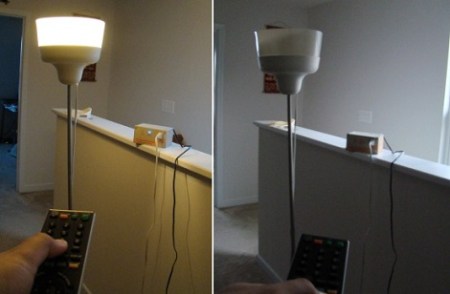
[RB] at Embedded Lab sent in a great guide on how to control appliances with a remote control using a really clever implementation of a decade counter and IR receiver.
The build itself is very simple – just a relay connected to mains power and a handful of resistors and transistors. The device is controlled with a decade counter and an infrared module usually found tucked away in the bezel of a TV.
When everything is plugged in, the first pulse from the remote switches the relay on, providing power to the outlet. When a second pulse is received, the reset pin on the decade counter is activated, setting the device back to its original off state. It’s a pretty clever build, and could be built with parts lying around the bench.
The project is powered through wall power with the help of a transformer and a 7805 regulator, but we think the size could be reduced with a pass-through power enclosure – the circuit certainly is small enough. In all, a very nice, low component count build.
















Great work good keep it up.
I like that….
http://www.amazon.com/IR-543-X10-Command-Console-Usa/dp/B000BOLDKG/ref=sr_1_1?ie=UTF8&qid=1310061166&sr=8-1
and kind of control lots of lights.
Kind of because X10 is the crappiest control system ever invented.
So the light will go on/off any time it gets a modulated IR signal? No much use in a room with a tv, hifi etc!
I have that exact X10 IR module and a few X10’s controlling lights and lamps. I will agree that it’s essentially a really bad control system and susceptible to all kinds of noise and interference. However, it works well enough in my apt so that I don’t need to go out of my way to build something.
Cool hack though, very useful.
While most of X10’s components are indeed crap.. if you spend a little more and get one of these nice, multi-home-code RF receivers with dedicated coax antenna:
http://www.wgldesigns.com/v572.html
Then X10 ends up working MUCH more reliably/smoothly. Add a few SmartHome/INSTEON components and things really start working smoothly. :)
If you really want nice stuff.. Look into the newer UPB standard and devices:
http://digitalavnew.com/what_is_upb.htm
Tweeks
The world is now reaching a high point in laziness!
Kind of primitive, but good idea.
here are two DIY alternatives that are IR noise-immune: http://bit.ly/ccE1bS and http://bit.ly/cgNKuK
Back when i was in high school i built something similar. It had 2 lamps to control and cycled through 4 states: all off, lamp 1 on, lamp 2 on, both on. The design was similar except that i bought two receivers, one in the 38KHz range and one in the 56KHz range to test which reacts to my TV tuner remote(the only one i used in that room). Then i used the other one for the project and made a simple emitter with a 555. The project is simple, but not practical. We need micros for this!